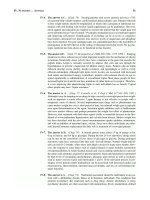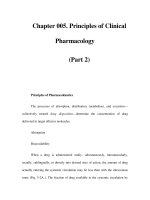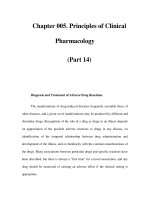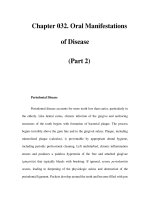Cytologic Detection of Urothelial Lesions - part 2 potx
Bạn đang xem bản rút gọn của tài liệu. Xem và tải ngay bản đầy đủ của tài liệu tại đây (335.24 KB, 20 trang )
10 1. Normal Morphology
Figure 1.3. Normal Urothelial Cells—voided urine: Large round nuclei,
frequently multiple, with prominent nucleoli are characteristic of normal
umbrella (superficial) cells. Contrast these with the normal intermediate
squamous cell in the lower left corner and in the center. (600x)
Normal Urothelial Histology and Cytology 11
Figure 1.4. Glandular Cells—bladder washing: Columnar cells in a uri-
nary specimen, if benign appearing, are of no clinical significance. They
may arise in a focus of normal glandular epithelium in the bladder, but they
may be mistaken for a glandular lesion. Cytomorphologic criteria should
be applied as for any body site. (600x)
12 1. Normal Morphology
Figure 1.5. Glandular Cells—bladder washing: Elongated glandular cells
surround degenerated debris. Follow-up showed endometriosis. (600x)
Normal Urothelial Histology and Cytology 13
Figure 1.6. Benign Urothelial Cells—catheterized urine: In this catheter-
ized urine, a loosely cohesive group of benign urothelial cells is present.
These cells have an elongated glandular appearance. The cells have small
dot-like nucleoli and abundant cytoplasm that is slightly frayed. (600x)
14 1. Normal Morphology
Figure 1.7. Benign Urothelial Cells—catheterized urine: A cluster of be-
nign urothelial cells is admixed with scattered benign superficial cells. The
cells have oval nuclei and frothy cytoplasm. The nuclear to cytoplasmic
ratio is slightly increased although the nuclei are small. (600x)
Normal Urothelial Histology and Cytology 15
Figure 1.8. Benign Squamous Cells—voided urine: Numerous benign
squamous cells are seen in this voided urine specimen from a 37 year
old woman. The majority of these squamous cells are intermediate in ap-
pearance. These squamous cells may originate in the bladder or vagina.
(600x)
16 1. Normal Morphology
Figure 1.9. Normal Cells—voided urine: Normal urothelial cells are char-
acterized by large round nuclei, often multiple, with prominent nucleoli
and vesicular cytoplasm. In this photograph, several squamous cells are
present and are characteristically without nucleoli. (400x)
Normal Urothelial Histology and Cytology 17
Figure 1.10. Vaginal Contaminant—voided urine: Acute inflammation
and benign squamous cells admixed with bacteria are seen in the back-
ground. Benign urothelial cells also are present. In some voided urines,
vaginal contaminant may obscure the benign urothelial cells. (600x)
18 1. Normal Morphology
Suggested Reading
Dabbs DJ: Cytology of pyelitis glandularis cystica. Acta Cytol 1992;
36:943–945.
Epstein JI, Amin MB, Reuter VR, Mostofi FK, and the Bladder Consensus
Conference Committee: The World Health Organization / International
Society of Urological Pathology consensus classification of urothelial
(transitional cell) neoplasms of the urinary bladder. Am J of Surg Path
1998; 22:1435–1448.
Koss LG: Diagnostic Cytology of the Urinary Tract. JB Lippincott,
Philadelphia, 1995.
2
Diagnostic Categories
Formatting the Report
Communication with the clinician is incredibly important, espe-
cially for lesions of the upper tract and borderline changes. Unfor-
tunately, there has yet to be a concensus conference on terminology
for urothelial cytology. Therefore, we propose the following cate-
gories be adopted (Table 1).
No cytologic atypia
Benign cellular changes
Atypia indeterminate for neoplasia
Low grade neoplasia
High grade neoplasia
Unsatisfactory
Needless to say, modifiers to neoplastic categories, such as “sus-
picious for” or “suggestive of” are the prerogatives of the patholo-
gist, and expected/accepted by our clinical colleagues. Repeat cy-
tologic sampling or further diagnostic studies should ensue in these
cases.
Criteria for unsatisfactory specimens are not defined. Voided
urines are usually less cellular than bladder washings, and will
vary depending upon the processing method routinely utilized. At
least 25cc of freshly collected urine should be recommended for
adequate cell retrieval in voided urine. The prudent pathologist
will develop an eye for the usual cellularity for both voided and
washed samples in his/her laboratory. When a sample has obscuring
19
20 2. Diagnostic Categories
Table 1. Comparative Features of Major Categories of Urothelial
Conditions
Normal Reactive Atypical Low Grade High Grade
Cellularity Single Single Groups Fragments Single/groups
Cytoplasm Textured, Bubbley Variable Opaque Variable
pale
Nucleus-size Small Enlarged Variable Larger Variable, large
Nucleus-shape Round Round Irregular Oval Very irregular
Nucleoli Tiny Obvious Variable Absent Often large
Chromatin Pale, Coarse, Variable Uniform, Irregular, dark
uniform uniform darker
N/C Low Increased Variable Increased High
Background Clean Inflamed Clean or Clean or Variable
inflamed bloody
lubricant in a washing (Fig. 2.1), or is very hypo-cellular in either
type of sample, a diagnosis of “Unsatisfactory” is advised, unless
there is any hint of significant atypia. Then the diagnosis must
express the morphologic changes and mention the scant cellularity
or obscuring factors as a quality indicator.
Morphologic Differences Dependent on Method
of Sample Collection
While the nuclear criteria may not provide evidence of neoplasia,
the growth pattern is oftentimes a significant clue to the ongoing
process. Sampling method will alter the composition of the spec-
imen, and is important to know before rendering an interpretation
(Table 2).
In spontaneously voided urine, a sufficient sample for diagnosis
may not be obtained. Large pseudopapillary cellular groups should
cause concern in a voided specimen, particularly if the clinical
history is unknown. The differential diagnosis includes instrumen-
tation artifact, resulting in large groups of urothelial cells (Fig. 2.2–
2.7). Catheterization will avoid vaginal contamination in a woman
and establish the source of blood, i.e., bladder vs. uterus. An irri-
gation specimen obtained during cystoscopy is the best source of
adequate epithelium to appreciate crowding produced by increased
Benign Cellular Changes—Normal/Reactive 21
Table 2. Cytologic Differences Depending on Collection Techniques
Voided Catheterized Washing Loop
Cellularity Low Higher Highest Usually high
Preservation Poor-medium Better Good Degenerated
Architecture Single cells Fragments Groups and Groups and
fragments single
Cell types Umbrella Umbrella, basal Umbrella, Enteric,
basal umbrella
Advantages Non-invasive Better specimen Best None
specimen
Disadvantages Degeneration, Instrumentation Invasive, Degeneration
scant, vaginal artifact, antibiotic
contamination infection prophylaxis
NC ratios, minimal increase in nuclear size, chromatin quality and
perhaps a mildly disordered arrangement of cells. Comparison with
normal urothelium produced by irrigation in the same sample will
prevent over-calling these usually cellular samples (Figs. 2.8–2.10).
Needless to say, clinicians are responsible for noting on the requi-
siton the method of collection. If lubricant is present (Fig. 2.11) a
voided sample is not a possibility; cell groups should be attributed
to mechanical disruption rather than to neoplasia, unless the indi-
vidual cell features and architecture within the fragments persuade
otherwise.
Benign Cellular Changes—Normal/Reactive
Normal urothelial cells have bland nuclear chromatin, uniformly
round nuclei, inconspicuous nucleoli, and frothy cytoplasm. Reac-
tive/inflammatory changes in urothelial cells are similar to those
of all epithelial cells, i.e., accentuated nucleoli, slightly coars-
ened chromatin, round nuclei and a variably increased nuclear-
cytoplasmic (NC) ratio (Figs. 2.12–2.14, 2.16–2.19). In contrast,
cells from low grade urothelial carcinoma have oval nuclei, indis-
cernible nucleoli, and high NC ratios (Figs. 3.7–3.19)
Most infectious agents are not obvious in voided urine or
washings, but occasionally trichomonads, evidence of polyoma
virus (decoy cells) (Figs. 2.20, 2.21), Herpes simplex virus
22 2. Diagnostic Categories
(Figs. 2.22, 2.23), cytomegalovirus (CMV) (Fig. 2.24) or human
papillomavirus (koilocytes) is seen (Figs. 2.25). Schistoma ova are
found rarely in our practice, but should be sought when extensive
squamous metaplasia is seen.
Renal tubular epithelial cells are usually so degenerated by
the time they reach the bladder that they resemble histiocytes
(Fig. 2.26). They are usually few in number, unless there is intrinsic
renal disease affecting the tubules. Cellular casts preserve the cyto-
morphology of these cells (Fig. 2.27), and are important to report.
Benign Non-epithelial Elements
Cytology reports should include not only cellular elements, but also
other features that have clinical significance. These include casts,
crystals, inclusions (Figs. 2.28–2.32), and ejaculate which may
include seminal vesicle cells, not to be mistaken for neoplastic cells.
Atypical Urothelial Cells Indeterminate
for Neoplasia
Unfortuntely, as in every other body site, cytologic samples from
the urinary tract are not always readily placed into distinct cate-
gories. An atypical interpretation is appropriate when morphologic
changes exceed those described as benign cellular changes, but
lack clear signs of neoplasia (Figs. 2.7, 2.15, 2.33). This is gener-
ally encountered when dealing with a sample from a patient with
a low grade lesion, especially those called “low malignant poten-
tial” (LMP), or in the presence of severe inflammation, calculus
disease, or following chemotherapy. Emerging ancillary tests, be-
yond the scope of this volume, will potentially bring clarity to these
frustrating lesions.
Note that “dysplasia” is not included as a diagnostic choice. In
the authors’ experience, cytologic samples rarely contain cells from
a dysplasia unless they have been mechanically dislodged. If they
are present, they should be placed in a low or high grade category
depending upon individual cell morphology.
Benign Cellular Changes 23
Figure 2.1. Benign Urothelial Cells—bladder washing: The purple frag-
ment is lubricant. Admixed are acute inflammatory cells as well as reactive
urothelial cells. Lubricant may be seen in bladder washing and catheterized
specimens. (600x)
24 2. Diagnostic Categories
Figure 2.2. Benign Urothelial Cells—catheterized urine: Degeneration
may be seen in catheterized urine specimens. In this case, degenerated
nuclei are admixed with smaller, hyperchromatic benign urothelial cells.
(600x)
Benign Cellular Changes 25
Figure 2.3. Benign Urothelial Cells—catheterized urine: A cluster of be-
nign urothelial cells is admixed with a few squamous cells. The urothelial
cells exhibit a moderately increased nuclear to cytoplasmic ratio although
the nuclei are relatively uniform to slightly irregular in contour. The cells
contain a variable chromatin pattern and the cytoplasm is homogeneous
(absence of vacuoles). Clusters of benign urothelial cells in catheterized
urine specimens should not be mistaken for low or high grade urothelial
carcinoma. (600x)
26 2. Diagnostic Categories
Figure 2.4. Benign Urothelial Cells—catheterized urine: In this catheter-
ized urine, a large group of benign urothelial cells is present at a low power.
At this power, one may be concerned for a low grade urothelial carcinoma.
However, such large clusters are often seen in catheterized urine specimens
and should not evoke a low grade carcinoma diagnosis. (200x)
Benign Cellular Changes 27
Figure 2.5. Reactive Urothelial Cells—catheterized urine: A large clus-
ter of degenerated, benign, reactive urothelial cells is seen. These cells
exhibit low nuclear to cytoplasmic ratios although the nuclei are irregular
in contour. The nuclear to cytoplasmic ratio is not increased. Several of the
cells show marked hyperchromasia, although degeneration explains this
phenomenon. (600x)
28 2. Diagnostic Categories
Figure 2.6. Reactive Urothelial Cells—catheterized urine: A cluster of
benign, degenerated urothelial cells is seen adjacent to a crystal. The more
preserved urothelial cells contain enlarged nuclei that are not hyperchro-
matic and may be seen at the edges of the large cluster. For the most part,
the nuclei are small and hyperchromatic. (600x)
Benign Cellular Changes 29
Figure 2.7. Atypical UrothelialCells—catheterized urine: Two large clus-
ters of atypical urothelial cells are seen. The cells exhibit an increased
nuclear to cytoplasmic ratio although the nuclei are not markedly hyper-
chromatic. The cytoplasm is granular and thereis an absenceof cytoplasmic
homogeneity. Nuclear overlap may be seen in catheterized specimens and
in this case, the nuclei vary in size, although for the most part are round in
shape. (600x)









